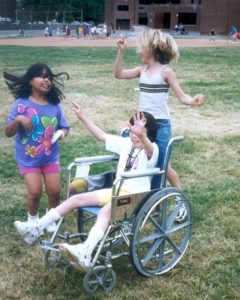Looking for information about inclusion of children with disabilities in our schools and communities? CPIR is very pleased to offer you this resource page, which will connect you with the great work and materials of the disability network nationwide and internationally.
Inclusion is part of a much larger picture than just placement in the regular class within school. It is being included in life and participating using one’s abilities in day to day activities as a member of the community. Inclusion is being a part of what everyone else is, being welcomed and embraced as a member who belongs It is being a part of what everyone else is, and being welcomed and embraced as a member who belongs. Inclusion can occur in schools, churches, playgrounds, work and in recreation.
—Kids Together, Inc.
The Basics
What is inclusion?
Visit Kids Together, which offers a wide range of materials on inclusion—its components, its benefits, rights to regular education, the role that assistive technology can play, and much more.
https://kidstogether.org/components-of-inclusive-ed/
Are IDEA’s LRE provisions a mandate for inclusion?
Read Considering LRE in Placement Decisions and you’ll have your answer. (LRE stands for “least restrictive environment.”)
https://www.parentcenterhub.orgplacement-lre/
Video | What is inclusion and why is it important?
Ms. Lawrence, the principal of Central Middle School, is eager to learn more about inclusion. At her superintendent’s suggestion, she sets up a meeting with Mr. Sherman, the principal at Monet High School. Watch this 4-minute video to find out what happens during their meeting. https://iris.peabody.vanderbilt.edu/module/inc/cresource/q1/p01/
Inclusion Basics course.
Learn about the philosophy and practices of inclusive education in this online module. Afterward, roam around the Inclusive Schools Network website for articles, videos, and more.
https://inclusiveschools.org/Course%20HTML%20Files/InclusionBasics/story.html
Resource Library | Inclusion Resources
The Inclusive Schools Network’s extensive Resource Library contains a variety of tools, tips, and strategies that help you evaluate and improve the status of inclusive education in your school. Browse by category and get lost in the plethora of inclusion resources right there at your fingertips!
https://inclusiveschools.org/inclusion-resources/
4 benefits of inclusion classrooms | Available in English and Spanish.
From Understood, this article is short and point to the point.
English | https://www.understood.org/en/articles/4-benefits-of-inclusive-classrooms
Spanish | https://www.understood.org/es-mx/articles/4-benefits-of-inclusive-classrooms
Videos | 10 examples of inclusion: For those who need to see it to believe it.
Here are 10 videos that are good examples on how particular schools put inclusion into practice.
https://www.friendshipcircle.org/blog/2014/02/05/10-examples-of-inclusion-for-those-who-need-to-see-it-to-believe-it/
Signs of an Inclusive School: A Parent’s Perspective on the Meaning and Value of Authentic Inclusion.
This article, written from a parent’s perspective, highlights a series of questions that school leadership, educators, and families can ask themselves in reflecting on whether their schools offer authentically inclusive experiences.
https://www.parentcenterhub.org/wp-content/uploads/2025/02/Signs-of-an-inclusive-schoolA-parents-perspectivePDF.pdf
Making Inclusion Happen
 Creating an inclusive school environment: A model for school leaders.
Creating an inclusive school environment: A model for school leaders.
This training module offers a general overview of the concepts that principals should consider when creating inclusive schools (est. completion time: 2 hours).
https://iris.peabody.vanderbilt.edu/module/inc/
Inclusion of students with significant cognitive disabilities: Supports in the general education classroom.
This module, developed in collaboration with the TIES Center, describes the benefits of including students with significant cognitive disabilities in general education classrooms. It also offers information on how teachers can plan for and teach these students in inclusive classrooms (est. completion time: 2 hours).
https://iris.peabody.vanderbilt.edu/module/scd/
Comprehensive inclusive education: General education and the inclusive IEP.
This resource is intended to guide IEP teams in a comprehensive inclusive education planning process based on the expectation that each student can actively participate, belong, contribute, and learn in the school and larger community.
https://publications.ici.umn.edu/ties/comprehensive-inclusive-education/main
Common sense tools: MAPS and CIRCLES for inclusive education.
From the Inclusion Network, this article describes in some detail two strategies teachers can use to fuel a successful inclusive education for all students. MAPS is a collaborative action planning process that brings the key actors in a child’s life together. CIRCLES of Support is an approach to understanding and building relationships with each other.
https://inclusion.com/1992/common-sense-tools-maps-and-circles-for-inclusive-education/
SWIFT in 60 video: Inclusive Academic Instruction.
This film focuses on how inclusive academic instruction provides a variety of instructional and assessment options that meet every student’s needs and promote learning. There is also a discussion guide (PDF) included as a resource to jumpstart the conversation.
https://swiftschools.org/docs/swift-in-60-video-inclusive-academic-instruction/
SWIFT in 60 video: Inclusive Behavior Instruction.
This film shows how inclusive behavior instruction is a proactive approach to teaching social behaviors that emphasizes positive goals and expectations so all students can successfully manage their behavior. There is also a discussion guide (PDF) included as a resource to jumpstart the conversation.
https://swiftschools.org/docs/discussion-guide-inclusive-behavior-instruction/
________________________________________________________
 **Highly Rated Resource! This CPIR resource was reviewed by 3-member panels of Parent Center staff working independently from one another to rate the quality, relevance, and usefulness of CPIR resources. This resource was found to be of “High Quality, High Relevance, High Usefulness” to Parent Centers.
**Highly Rated Resource! This CPIR resource was reviewed by 3-member panels of Parent Center staff working independently from one another to rate the quality, relevance, and usefulness of CPIR resources. This resource was found to be of “High Quality, High Relevance, High Usefulness” to Parent Centers.
________________________________________
Would you like to keep reading about placement issues?
Placement, Short-and-Sweet
Placement, in overview. Here are the basics, if you please.
Considering LRE in Placement Decisions
LRE–least restrictive environment–is a foundational principle in IDEA. What is LRE, and how does it shape placement decisions? This discussion takes a detailed look.
Starter Set of Resources on LRE
Looking for information, resources, and technical assistance to help you and others support children with disabilities in their least restrictive environment in school? Here’s a starter list of places to look online.
School Inclusion (You’re already here!)
Looking for information about, and best practices for, the inclusion of students with disabilities in regular classrooms and in the daily activities of school?
Placement and School Discipline
How is a child’s placement affected when he or she is being disciplined for a violation of the student code? Find out what authority school personnel have to remove a child from his or her current placement, what authority the hearing officer has, what constitutes a change of placement, and what placement the child will have during any appeal.
Links checked, September 2025


